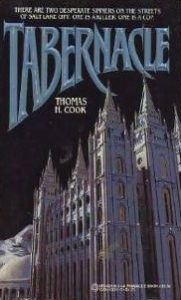 Author: Thomas H. Cook
Author: Thomas H. Cook
Title: Tabernacle
Publisher: Pinnacle Books
Publication Date: 1983
(Reviewed by David Harris, Sept. 21, 2018)
The premise of this story is good. A religious extremist resorts to violence in order to eradicate social elements which are sullying the clean, orderly streets of Salt Lake City and undermining the influence of the Mormon pioneers who built and settled the city and whose descendants have been running it ever since.
Unfortunately, the author doesn’t know either Salt Lake City or Mormonism all that well, and this lack of a sufficient background distracts the reader who is familiar with them from becoming completely immersed in the tale. For example, I don’t know of any expensive jewelry shops that ever existed along 1st Street, even back in the 1980s when this book was written, and the author plays fast and loose with such street names as Temple Street and South 2nd, which are tantalisingly close to the names of actual streets but too muddled to form any sort of mental map of. (Are we on North or South Temple, both of which run east and west, or on West Temple, which runs north and south? Is this 2nd South or are we now up in the Avenues on 2nd Street?)
Also, the Twelve Apostles walk the streets as if they were completely unknown to the local population, and no adoring crowds flock around them in hopes of obtaining an autograph or a thoughtful nugget of wisdom or spiritual advice. And one of them corrects our protagonist, Tom, when he refers to a recently excommunicated member, stating that, in the Mormon church, it’s disfellowshipment and not excommunication. (In fact, both are used, one being a less serious punishment than the other.)
Tom Jackson, the protagonist of this tale, is a police officer who has come to Salt Lake City to escape the corruption of New York City, where he witnessed his partner accepting a bribe from a violent criminal who then murdered an important witness and his young daughter. He’s the only realistic character in this book. We learn about why he left New York only gradually over the course of the novel in short, dreamlike vignettes, and this part of the tale works well.
But Tom’s partner and the chief of police and other officers on the force come across as caricatures, faithful Mormon men who plot to protect the reputations of two deceased Church leaders whose deaths have occurred under suspicious circumstances involving women who are not their wives. And the one or two renegade non-Mormons on the force are likewise caricatures of the non-Mormons who hold themselves aloof from members of the major ethnic/religious clique all along the Wasatch Front.
The killer, too, comes across as simplistic in the scenes where we encounter him. We gain a brief insight into his personality from one of his colleagues during one short scene (before we know who he is), but he mostly comes across as a vicious and mindless jerk who treats his wife and children with the same contempt he does everyone else he comes into contact with.
As a detective novel, Tabernacle is a reasonably respectable read. But, if you’re interested in something more informed about Utah and the Mormon culture, try Andrew Hunt‘s City of Saints or A Killing in Zion, the first two in a series of detective novels set in 1930s Salt Lake City.

Michael Austin wrote an article about these kind of novels. “Troped by the Mormons: The Persistence of 19th Century Mormon Stereotypes in Contemporary Detective Fiction”. Sunstone, August 1998.
About “Tabernacle”, he wrote, “Features Detective Tom Jackson, a hard-boiled New York cop living in Salt Lake City. The novel opens when the city is rocked by a series of murders that appear unconnected: a prostitute, a reporter, a Mormon public-relations official, a BYU student, and a Church archivist and his two sons. As he investigates, though, Jackson discovers that each of the victims had some connection to the Church’s recently changed doctrine on African-Americans and the Priesthood.” https://www.sunstonemagazine.com/pdf/111-51-71.pdf